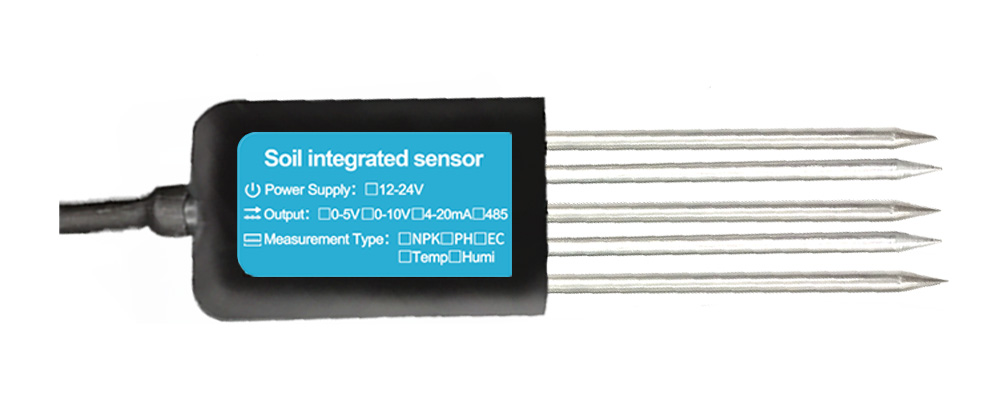Agriculture has always been a fundamental aspect of human civilization, providing food and resources essential for our survival. However, traditional farming methods often lack precision and efficiency, leading to resource wastage, environmental degradation, and reduced yields. In recent years, the emergence of soil sensor technology has revolutionized farming practices by enabling farmers to gain real-time insights into soil conditions. This article explores the growing trend of using soil sensors in precision agriculture and the transformative impact they have on farming.

Understanding Precision Agriculture:
Precision agriculture is an innovative approach to farming that employs advanced technologies to optimize productivity while minimizing waste. It involves collecting and analyzing data about various factors that affect crop growth, such as soil moisture, nutrient levels, temperature, and pH. By utilizing this information, farmers can make informed decisions and precisely tailor their agricultural practices to meet the specific needs of each crop, resulting in improved yields and resource efficiency.
The Role of Soil Sensors: Soil sensors play a crucial role in precision agriculture by providing accurate and real-time information about the soil conditions. These sensors are designed to measure key parameters like soil moisture, temperature, nutrient concentrations, and salinity levels. By deploying soil sensors across their fields, farmers can continuously monitor these vital metrics and make data-driven decisions regarding irrigation, fertilization, and other farming practices. This level of precision enables farmers to optimize resource allocation and maximize crop performance.
Soil Moisture Sensors: One of the primary applications of soil sensors in precision agriculture is measuring soil moisture levels. Soil moisture sensors are typically installed at different depths in the soil profile, allowing farmers to monitor moisture content at various stages. This information helps farmers determine the optimal time for irrigation, preventing overwatering or water stress. By maintaining soil moisture at the ideal levels, plants can efficiently absorb nutrients, reduce water waste, and enhance overall crop health.
Nutrient Sensors: Proper nutrient management is critical for healthy plant growth and high-quality yields. Soil sensors equipped with nutrient probes allow farmers to measure essential elements like nitrogen, phosphorus, and potassium concentrations in the soil. This data enables farmers to adjust fertilizer applications precisely, avoiding excessive or insufficient nutrient supply. By optimizing nutrient levels, farmers can minimize environmental pollution, reduce production costs, and optimize crop nutrition.
Temperature and pH Sensors: Soil temperature and pH are crucial factors that influence plant growth and nutrient availability. Soil sensors equipped with temperature and pH probes provide real-time data on these parameters. This information allows farmers to make informed decisions regarding planting schedules, crop selection, and soil amendments. By ensuring the optimal temperature and pH range, farmers can create favorable conditions for root development, microbial activity, and nutrient uptake, ultimately leading to improved crop productivity.
Advantages of Soil Sensor Networks: The use of soil sensor networks in precision agriculture offers several advantages. Firstly, these networks provide continuous and real-time monitoring, allowing farmers to detect changes in soil conditions promptly. This enables them to take immediate action, such as adjusting irrigation schedules or applying corrective measures, to prevent crop stress or yield losses. Secondly, soil sensor networks help farmers identify spatial variations in soil properties within their fields, enabling site-specific management strategies. By tailoring farming practices based on these variations, farmers can optimize resource allocation and improve overall field productivity.
Integration with Data Analytics and Decision Support Systems: The sheer volume of data generated by soil sensors necessitates advanced data analytics techniques for effective interpretation and decision-making. Farmers can integrate soil sensor data with weather data, satellite imagery, and historical records to gain comprehensive insights into their fields. Data analytics platforms and decision support systems equipped with machine learning algorithms can analyze this data and provide actionable recommendations for optimizing crop management. These systems can suggest precise irrigation schedules, fertilizer applications, and pest management strategies, leading to increased productivity and reduced environmental impact.
Potential Challenges and Future Directions: While soil sensors have proven to be valuable tools in precision agriculture, some challenges remain. The cost of sensor deployment and maintenance can be a significant barrier for small-scale farmers. Additionally, the interpretation of sensor data requires technical expertise and training. However, ongoing advancements in sensor technology, automation, and data analytics are addressing these challenges and making soil sensors more accessible and user-friendly. The future of soil sensor technology lies in the development of wireless and autonomous sensor networks, improved sensor accuracy, and enhanced integration with other agricultural technologies.

Conclusion: Soil sensors are transforming farming practices by providing farmers with real-time insights into soil conditions and enabling precise decision-making. With soil moisture sensors, nutrient probes, temperature and pH sensors, farmers can optimize irrigation, fertilization, and other farming practices to maximize crop productivity while minimizing resource waste. The integration of soil sensor networks with data analytics and decision support systems further enhances their effectiveness. As soil sensor technology continues to evolve, it holds the potential to revolutionize agriculture, making it more sustainable, efficient, and productive, thereby ensuring food security for future generations.
